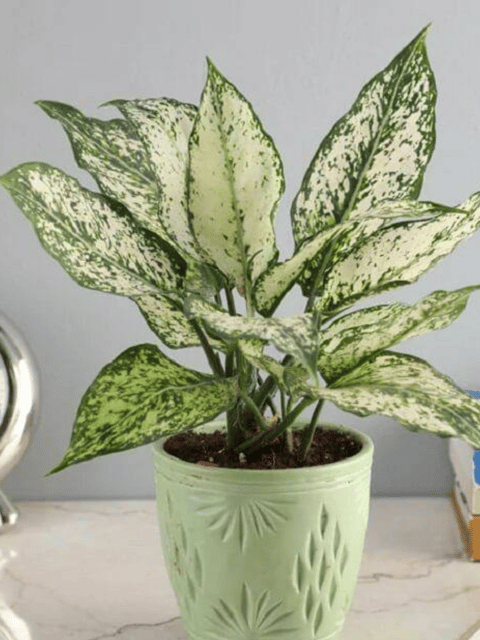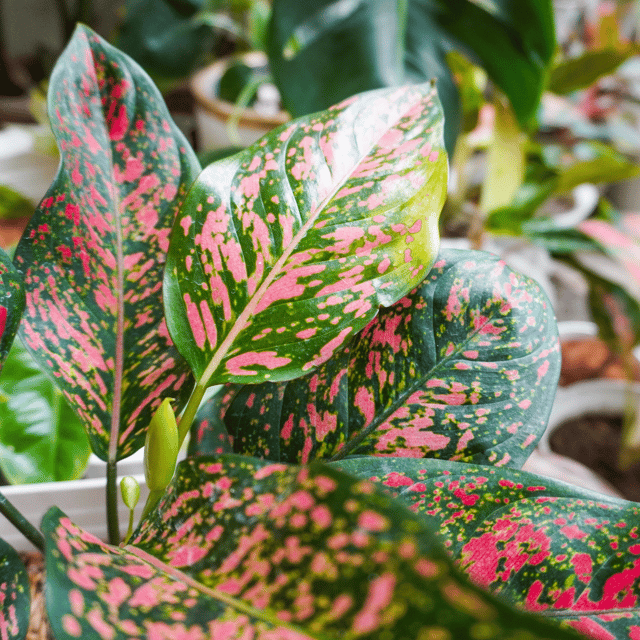Currency
Language
Aglaonema
Aglaonema Plants are a standout choice for anyone looking to enhance their indoor spaces with greenery. Known for their striking foliage, low-maintenance care, and numerous benefits, these plants are a favorite among homeowners...
Aglaonema Plants are a standout choice for anyone looking to enhance their indoor spaces with greenery. Known for their striking foliage, low-maintenance care, and numerous benefits, these plants are a favorite among homeowners, office workers, and gardening enthusiasts alike. In this guide, we’ll dive into the different Aglaonema varieties, essential care tips, benefits, and how to buy them online.
Introduction to Aglaonema Plants
Aglaonema, often referred to as the “Chinese Evergreen,” is a popular indoor plant native to tropical and subtropical regions of Asia. With its lush, colorful leaves and adaptability to indoor environments, Aglaonema is celebrated for its aesthetic appeal and ease of care. This plant is perfect for adding a touch of nature to your home or office while requiring minimal maintenance.
Different Varieties of Aglaonema Plants
Aglaonema Plants come in a range of varieties, each with unique characteristics and aesthetic appeal. Here are some popular types:
1. Aglaonema Snow White
The Aglaonema Snow White is known for its stunning white and silver foliage. This variety is perfect for brightening up any room with its elegant and sophisticated look. It’s an excellent choice for modern interiors and can complement both contemporary and traditional decor.
2. Red Aglaonema
Featuring vibrant red and green leaves, the Red Aglaonema adds a pop of color to any space. Its striking appearance makes it a focal point in any room, perfect for those looking to make a bold statement with their indoor plants.
3. Aglaonema Pink Plant
The Aglaonema Pink Plant stands out with its beautiful pink and green leaves. This variety is ideal for adding a touch of color and vibrancy to your indoor garden. Its unique hue can enhance the overall aesthetic of your living space.
4. Aglaonema Lipstick Plant
Named for its rich, lipstick-red coloration, this variety of Aglaonema brings a splash of color and elegance to any room. Its bold appearance makes it a favorite for those who want a distinctive and eye-catching plant.
Aglaonema Plant Care
Aglaonema Plants are relatively easy to care for, making them ideal for both novice and experienced plant enthusiasts. Here are some essential care tips:
Light Requirements
Aglaonemas thrive in low to medium light conditions, making them perfect for areas with indirect sunlight. Avoid placing them in direct sunlight, which can scorch their leaves. If your plant isn’t getting enough light, you might notice slower growth or less vibrant foliage.
Watering Schedule
Water your Aglaonema when the top inch of the soil feels dry. Overwatering can lead to root rot, so ensure the pot has good drainage and avoid letting the plant sit in water. During the winter months, reduce watering as the plant’s growth slows down.
Soil Preferences
Use a well-draining potting mix for Aglaonema. A mix designed for houseplants or a combination of peat, perlite, and pine bark works well. Ensure the pot has drainage holes to prevent waterlogging.
Repotting and Fertilizing
Repot your Aglaonema every 1-2 years to refresh the soil and accommodate growth. Use a balanced, water-soluble fertilizer during the growing season (spring and summer) to promote healthy growth. Avoid fertilizing in the winter when the plant’s growth slows.
Common Issues
Watch for signs of leaf discoloration or spots, which can indicate overwatering or pest issues. Regularly check the undersides of the leaves for pests such as spider mites or aphids, and treat them promptly.
Benefits of Aglaonema Plants
Aglaonema Plants offer several benefits, making them an excellent choice for indoor environments:
Air-Purifying Qualities
Aglaonemas are effective at removing toxins from the air, including formaldehyde and benzene. This helps improve indoor air quality and creates a healthier living environment.
Stress Reduction and Mood Enhancement
Indoor plants like Aglaonema can have a calming effect and reduce stress. Their presence adds a touch of nature to your surroundings, which can boost mood and overall well-being.
Aesthetic Appeal
With their beautiful foliage and varied colors, Aglaonemas enhance the aesthetic appeal of any room. They are versatile plants that fit well with various interior design styles, adding elegance and charm to your home or office.
Buying Aglaonema Plants Online
Purchasing Aglaonema Plants online offers convenience and access to a wide variety of options. Here are some tips for a successful online purchase:
What to Look for in Plant Health
When buying Aglaonema Plants online, look for healthy plants with vibrant foliage. Avoid plants with yellowing leaves or signs of pests. Ensure that the plant is well-packaged to avoid damage during shipping.
Understanding Plant Pricing
Aglaonema plant prices can vary based on variety, size, and seller. Compare prices from different sellers to get a fair deal. Remember that higher-quality plants may come with a higher price tag, but they often offer better longevity and aesthetics.
Aglaonema Plant Care Tips for Longevity
To keep your Aglaonema Plant thriving for years, follow these practical care tips:
Adjusting Care Routines
Adapt your care routine based on seasonal changes. In winter, reduce watering and avoid fertilizing. During the growing season, increase light exposure and watering frequency as needed.
Enhancing Plant Resilience
Ensure proper airflow around your plant to prevent fungal infections. Regularly dust the leaves to keep them clean and healthy. Use neem oil or insecticidal soap to manage pests.
Preventing Common Diseases
Monitor your plant for signs of diseases such as leaf spot or root rot. Maintain good hygiene and avoid overwatering to prevent these issues. If problems arise, address them promptly to avoid spreading.
Decorating with Aglaonema Plants
Aglaonema Plants can enhance your interior design with their vibrant foliage and adaptability. Here are some decorating ideas:
Incorporating into Interior Design
Use Aglaonemas to add color and texture to your decor. They work well in various settings, from modern and minimalist to traditional and eclectic. Place them in decorative pots to complement your furniture and color scheme.
Placement Suggestions
Position Aglaonemas in areas with indirect light, such as near windows or in well-lit corners. They can also be used as focal points in rooms or grouped with other indoor plants for a lush, green effect.
Complementing Other Plants
Aglaonemas pair well with other indoor plants like peace lilies or pothos. Create a mini indoor garden by combining different plant types with varying heights and textures for a dynamic look.
FAQs About Aglaonema Plants
What are the best conditions for growing Aglaonema Plants indoors?
Aglaonemas thrive in low to medium light conditions and prefer well-draining soil. They are adaptable to various indoor environments and do well with moderate humidity.
How often should I water my Aglaonema Plant?
Water your Aglaonema when the top inch of soil feels dry. Typically, this means watering every 1-2 weeks, but adjust based on the plant’s environment and seasonal changes.
Are Aglaonema Plants safe for pets?
Aglaonemas are considered non-toxic to pets, making them a safe choice for homes with cats and dogs. However, it's always a good idea to monitor pets around plants to prevent any accidental ingestion.
How can I propagate Aglaonema Plants at home?
Aglaonema Plants can be propagated through stem cuttings. Take a cutting with a few leaves and nodes, place it in water or soil, and keep it in a warm, bright location. Roots should develop within a few weeks.
Explore our curated collection of Aglaonema Plants available for purchase on Paudhewale and transform your indoor space with these beautiful, low-maintenance plants. For more tips and updates on plant care, sign up for our newsletter or follow us on social media!


